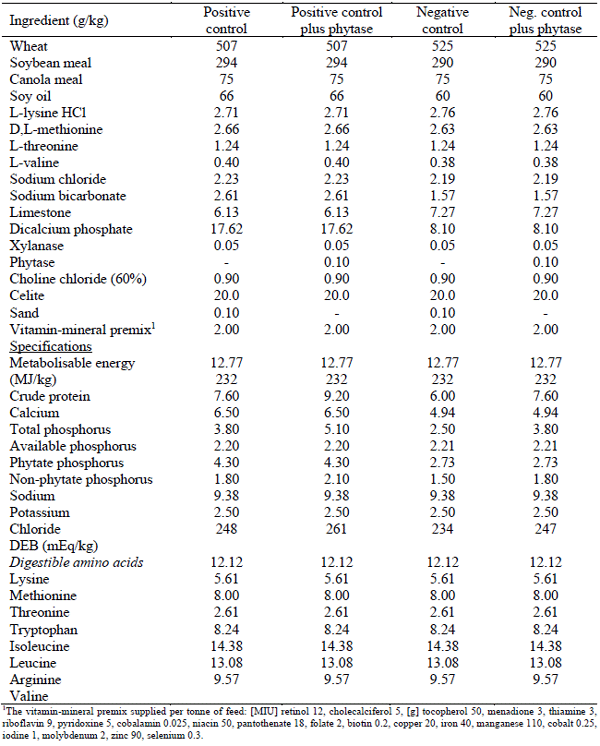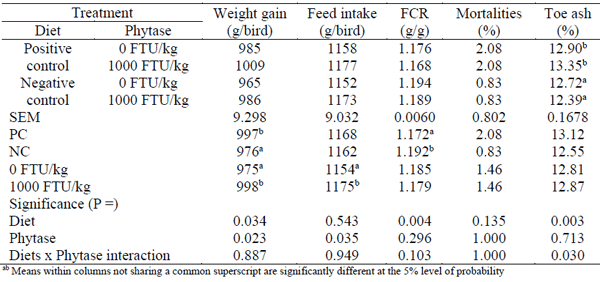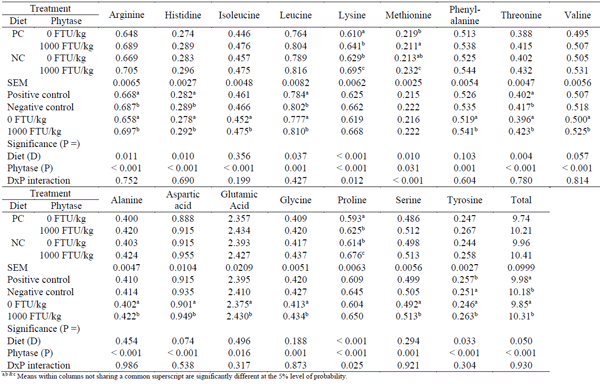Exogenous Phytase Enhances Weight Gains and Increases Ileal Amino Acid Disappearance Rates in Broiler Chickens
Published: November 18, 2021
By: P.V. CHRYSTAL 1,2; P.H. SELLE 1; S.Y. LIU 1; J.Y. LI 3 and Y.M. BAO 4 / 1 Poultry Research Foundation, Camden NSW 2570; 2 Baiada Poultry, Pendle Hill NSW 2145; 3 Guang VTR Biotech Co., Ltd, Zhuhai, China; 4 Redox Pty Ltd, Minto NSW 2566.
Summary
The present study determined phytase efficacy in broiler chickens offered wheat-based diets from 1 to 21 days post-hatch. Exogenous phytase significantly increased weight gains and feed intakes and increased apparent ileal disappearance rates of the sixteen amino acids assessed by a total of 4.67% (10.31 versus 9.85 g/bird/day; P < 0.001).
I. INTRODUCTION
The inclusion of exogenous phytases in diets for broiler chickens has developed into a routine practice because of their positive phosphoric and extra-phosphoric effects. On one hand, phytase liberates phytate-bound phosphorus (PP) which is found in all plant-sourced feedstuffs as the dominant P fraction. On the other, phytase enhances amino acid (AA) digestibilities, essentially because they prevent the de novo formation of binary protein-phytate complexes in the gut (Selle et al., 2012). Whilst several phytases are available in Australia, the exogenous phytase used in this study is a new entrant into the Australian market. Thus, the purpose of this study was to evaluate this exogenous phytase in respect of growth performance, bone mineralisation and AA disappearance rates from the ileum in broiler chickens offered broiler starter crumbles from 1 to 21 days post-hatch using typical Australian-sourced feed ingredients.
II. METHODOLOGY
The experimental protocol was approved by the Animal Ethics Committee of The University of Sydney. A total of 960 day-old male Ross 308 birds were randomly assigned to 4 treatments with 6 replicates of 40 birds per pen. The design was a 2 × 2 factorial array of treatments with wheat-based diets, either a positive (PC) or a negative control (NC), without and with a bacterial (Escherichia coli) phytase expressed in Pichia pastoris (Microtech 10000 plus; Guandong VTR Biotech Co Ltd) at an inclusion of 1000 FTU/kg. The NC diets were formulated with reductions of 1.6 g/kg Ca, 1.3 g/kg P and 0.3 g/kg Na relative to the PC diets as shown in Table 1. The diets were steam-pelleted at a conditioning temperature of 80ºC and phytase activities analysed. The two non-supplemented diets contained an average of 354 FTU/kg whilst the two supplemented diets contained 1134 FTU/kg phytase activity, post steam-pelleting. Growth performance was monitored from 1 to 21 days post-hatch. At the conclusion of the starter phase, six birds per replicate pen were euthanased and digesta samples from the distal ileum and toes taken to determine apparent AA digestibility coefficients (ADC) and bone mineralisation by standard procedures. AA disappearance rates (g/bird/day) were calculated from the following equation: disappearance rate(g/bird/day) = dietary AA concentration(g/kg) x daily feed intake(g/bird) x ADC
Experimental data was subjected to two-way analyses of variance using the IBM® SPSS® Version 24 statistical package.
Table 1 - Composition and nutrient specifications of starter diets (1 to 21 days post-hatch).

III. RESULTS AND DISCUSSION
Overall growth performance of birds in the present study compared favourably with the 2019 Ross 308 performance objectives for 1 to 21 days post-hatch. The transition from PC to NC diets depressed weight gain by 2.11% (976 versus 997 g/bird; P < 0.05) and phytase increased weight gain by 1.33% (988 versus 975 g/bird; P < 0.025) as shown in Table 2. Phytase similarly increased weight gains in both PC and NC diets by 2.44% and 2.18%, respectively and increased feed intake by 1.82% (1175 versus 1154 g/bird; P < 0.05). The transition from PC to NC diets compromised FCR by 1.71% (1.192 versus 1.172; P < 0.005). The 1.46% mortality rate was not influenced by treatment. A treatment interaction (P < 0.05) was observed for toe ash but the likelihood is that the overall result of 12.84% was indicative of adequate bone mineralisation. Dietary treatments on apparent ileal disappearance rates of sixteen AA are shown in Table 3 where treatment interactions were observed for lysine (P < 0.05) and proline (P < 0.05). Given this caveat, phytase significantly increased all AA disappearance rates culminating in a 4.67% increase (10.31 versus 9.85 g/bird/day; P < 0.001) in total disappearance rates. The transition from PC to NC diets significantly increased disappearance rates of arginine, histidine, leucine, methionine and threonine but decreased that of tyrosine.
Table 2 - Effects of dietary treatments on growth performance from 1 to 21 days post-hatch and bone mineralisation expressed as toe ash.

Phytase increased ileal AA disappearance rates or, effectively, their uptakes from the small intestine. The likelihood is the result of phytase enhancing both protein digestion by retarding the formation of binary protein-phytate complexes which are refractory to pepsin digestion and AA absorption. Phytase has been shown to have positive impacts on sodium pump activity along the small intestine in poultry, which would facilitate the co-absorption of AA and sodium via several Na+-dependent transport systems (Selle et al., 2012; Akter et al., 2019).
Table 3 - Effects of dietary treatments on apparent disappearance rates (g/bird/day) of amino acids at 21 days post-hatch.

Abstract presented at the 30th Annual Australian Poultry Science Symposium 2020. For information on the next edition, click here.
References
Akter M, Graham H & Iji PA (2019) Journal of Animal Science and Technology 61: 87-97.
Selle PH, Cowieson AJ, Cowieson NP & Ravindran V (2012) Nutrition Research Reviews 25: 1-17.
Content from the event:
Related topics:
Authors:
Baiada Poultry
The University of Sydney
The University of Sydney
Recommend
Comment
Share

Would you like to discuss another topic? Create a new post to engage with experts in the community.










.jpg&w=3840&q=75)